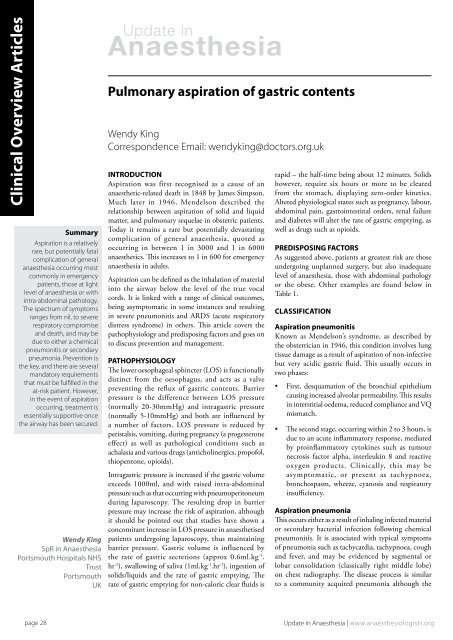Surgically placed rectus sheath catheters - The Global Regional ...
Surgically placed rectus sheath catheters - The Global Regional ...
Surgically placed rectus sheath catheters - The Global Regional ...
You also want an ePaper? Increase the reach of your titles
YUMPU automatically turns print PDFs into web optimized ePapers that Google loves.
Clinical Overview Articles<br />
Summary<br />
Aspiration is a relatively<br />
rare, but potentially fatal<br />
complication of general<br />
anaesthesia occurring most<br />
commonly in emergency<br />
patients, those at light<br />
level of anaesthesia or with<br />
intra-abdominal pathology.<br />
<strong>The</strong> spectrum of symptoms<br />
ranges from nil, to severe<br />
respiratory compromise<br />
and death, and may be<br />
due to either a chemical<br />
pneumonitis or secondary<br />
pneumonia. Prevention is<br />
the key, and there are several<br />
mandatory requirements<br />
that must be fulfilled in the<br />
at-risk patient. However,<br />
in the event of aspiration<br />
occurring, treatment is<br />
essentially supportive once<br />
the airway has been secured.<br />
Wendy King<br />
SpR in Anaesthesia<br />
Portsmouth Hospitals NHS<br />
Trust<br />
Portsmouth<br />
UK<br />
Update in<br />
Anaesthesia<br />
Pulmonary aspiration of gastric contents<br />
Wendy King<br />
Correspondence Email: wendyking@doctors.org.uk<br />
INTRODUCTION<br />
Aspiration was first recognised as a cause of an<br />
anaesthetic-related death in 1848 by James Simpson.<br />
Much later in 1946, Mendelson described the<br />
relationship between aspiration of solid and liquid<br />
matter, and pulmonary sequelae in obstetric patients.<br />
Today it remains a rare but potentially devastating<br />
complication of general anaesthesia, quoted as<br />
occurring in between 1 in 3000 and 1 in 6000<br />
anaesthetics. This increases to 1 in 600 for emergency<br />
anaesthesia in adults.<br />
Aspiration can be defined as the inhalation of material<br />
into the airway below the level of the true vocal<br />
cords. It is linked with a range of clinical outcomes,<br />
being asymptomatic in some instances and resulting<br />
in severe pneumonitis and ARDS (acute respiratory<br />
distress syndrome) in others. This article covers the<br />
pathophysiology and predisposing factors and goes on<br />
to discuss prevention and management.<br />
PATHOPHYSIOLOGY<br />
<strong>The</strong> lower oesophageal sphincter (LOS) is functionally<br />
distinct from the oesophagus, and acts as a valve<br />
preventing the reflux of gastric contents. Barrier<br />
pressure is the difference between LOS pressure<br />
(normally 20-30mmHg) and intragastric pressure<br />
(normally 5-10mmHg) and both are influenced by<br />
a number of factors. LOS pressure is reduced by<br />
peristalsis, vomiting, during pregnancy (a progesterone<br />
effect) as well as pathological conditions such as<br />
achalasia and various drugs (anticholinergics, propofol,<br />
thiopentone, opioids).<br />
Intragastric pressure is increased if the gastric volume<br />
exceeds 1000ml, and with raised intra-abdominal<br />
pressure such as that occurring with pneumoperitoneum<br />
during laparoscopy. <strong>The</strong> resulting drop in barrier<br />
pressure may increase the risk of aspiration, although<br />
it should be pointed out that studies have shown a<br />
concomitant increase in LOS pressure in anaesthetised<br />
patients undergoing laparoscopy, thus maintaining<br />
barrier pressure. Gastric volume is influenced by<br />
the rate of gastric secretions (approx 0.6ml.kg -1 .<br />
hr -1 ), swallowing of saliva (1ml.kg -1 .hr -1 ), ingestion of<br />
solids/liquids and the rate of gastric emptying. <strong>The</strong><br />
rate of gastric emptying for non-caloric clear fluids is<br />
rapid – the half-time being about 12 minutes. Solids<br />
however, require six hours or more to be cleared<br />
from the stomach, displaying zero-order kinetics.<br />
Altered physiological states such as pregnancy, labour,<br />
abdominal pain, gastrointestinal orders, renal failure<br />
and diabetes will alter the rate of gastric emptying, as<br />
well as drugs such as opioids.<br />
PREDISPOSING FACTORS<br />
As suggested above, patients at greatest risk are those<br />
undergoing unplanned surgery, but also inadequate<br />
level of anaesthesia, those with abdominal pathology<br />
or the obese. Other examples are found below in<br />
Table 1.<br />
CLASSIFICATION<br />
Aspiration pneumonitis<br />
Known as Mendelson’s syndrome, as described by<br />
the obstetrician in 1946, this condition involves lung<br />
tissue damage as a result of aspiration of non-infective<br />
but very acidic gastric fluid. This usually occurs in<br />
two phases:<br />
• First, desquamation of the bronchial epithelium<br />
causing increased alveolar permeability. This results<br />
in interstitial oedema, reduced compliance and VQ<br />
mismatch.<br />
• <strong>The</strong> second stage, occurring within 2 to 3 hours, is<br />
due to an acute inflammatory response, mediated<br />
by proinflammatory cytokines such as tumour<br />
necrosis factor alpha, interleukin 8 and reactive<br />
oxygen products. Clinically, this may be<br />
asymptomatic, or present as tachypnoea,<br />
bronchospasm, wheeze, cyanosis and respiratory<br />
insufficiency.<br />
Aspiration pneumonia<br />
This occurs either as a result of inhaling infected material<br />
or secondary bacterial infection following chemical<br />
pneumonitis. It is associated with typical symptoms<br />
of pneumonia such as tachycardia, tachypnoea, cough<br />
and fever, and may be evidenced by segmental or<br />
lobar consolidation (classically right middle lobe)<br />
on chest radiography. <strong>The</strong> disease process is similar<br />
to a community acquired pneumonia although the<br />
page 28<br />
Update in Anaesthesia | www.anaesthesiologists.org
















